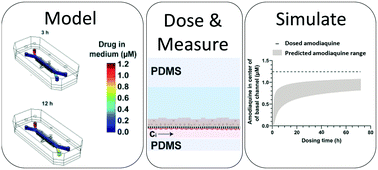Simulating drug concentrations in PDMS microfluidic organ chips†
Abstract
Microfluidic organ-on-a-chip (Organ Chip) cell culture devices are often fabricated using polydimethylsiloxane (PDMS) because it is biocompatible, transparent, elastomeric, and oxygen permeable; however, hydrophobic small molecules can absorb to PDMS, which makes it challenging to predict drug responses. Here, we describe a combined simulation and experimental approach to predict the spatial and temporal concentration profile of a drug under continuous dosing in a PDMS Organ Chip containing two parallel channels separated by a porous membrane that is lined with cultured cells, without prior knowledge of its log P value. First, a three-dimensional finite element model of drug loss into the chip was developed that incorporates absorption, adsorption, convection, and diffusion, which simulates changes in drug levels over time and space as a function of potential PDMS diffusion coefficients and log P values. By then experimentally measuring the diffusivity of the compound in PDMS and determining its partition coefficient through mass spectrometric analysis of the drug concentration in the channel outflow, it is possible to estimate the effective log P range of the compound. The diffusion and partition coefficients were experimentally derived for the antimalarial drug and potential SARS-CoV-2 therapeutic, amodiaquine, and incorporated into the model to quantitatively estimate the drug-specific concentration profile over time measured in human lung airway chips lined with bronchial epithelium interfaced with pulmonary microvascular endothelium. The same strategy can be applied to any device geometry, surface treatment, or in vitro microfluidic model to simulate the spatial and temporal gradient of a drug in 3D without prior knowledge of the partition coefficient or the rate of diffusion in PDMS. Thus, this approach may expand the use of PDMS Organ Chip devices for various forms of drug testing.

- This article is part of the themed collection: Lab on a Chip HOT Articles 2021


 Please wait while we load your content...
Please wait while we load your content...
